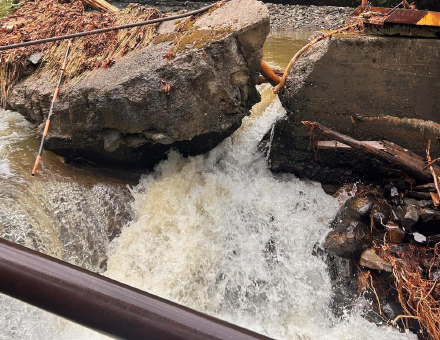SAM Magazine—Greenville Junction, Maine, Jan. 12, 2024—The nonprofit group that operates Maine’s Big Moose Mountain is forging ahead with its ski operations despite a recent storm that crippled its snowmaking system. Friends of the Mountain
Friends of the Mountain
A few degrees colder and the Dec. 18 storm could have been a boon for the Piscataquis County ski area, previously known as Big Squaw Mountain. Instead of snow, however, the storm brought torrential rains and high winds, causing widespread flooding and power outages. (Other resorts were hit hard, as well.)
The storm left Big Moose Mountain with no power, inaccessible roads, a damaged snowmaking pump house, and a leaky snowmaking pond. All but the latter have since been repaired, but the leaking dam meant that the ski area’s runoff water supply was inoperable at the temperatures needed to make snow.
As a result, Big Moose will be relying exclusively on natural snow for the remainder of the 2023-24 ski season, said Amy Lane, president and founder of Friends of the Mountain, the 501(c)3 nonprofit organization that has operated the previously shuttered ski area since 2013.
“Right now, we’re just hoping it snows, and it usually does,” said Lane, adding that the storm damage has now pushed addressing snowmaking to the top of Big Moose’s offseason project list. “A little bit of snowmaking would help, but right now we’re completely wiped out.”
Big Moose announced on Jan. 10 that opening day would be Jan. 14, with operations limited to the beginner area. Weather dependent, the nonprofit group will operate as much as possible of the 14-trail, 600-acre ski area on the lower elevations of the mountain.
In the decade since it took over operations of the ski area, Friends of the Mountain has made some significant investments, fueled largely by donations and corporate partnerships. Major capital purchases have included two snowcats and a new conveyor lift for the beginner area. The group invested $250,000 in 2023 to overhaul its 1986 Borvig triple chairlift, which included replacing the electric drive, controls, communications line, electrical service, braking system, safeties, and loading ramp.
More elusive has been restoring access to the summit. A 1967-vintage Stadeli double chair that once gave full access to the ski area’s 1,700 feet of vertical finally gave out in 2004, and has not been replaced.
Lane said the estimated cost of restoring lift service to Big Moose’s summit is about $5 million; meanwhile, however, volunteers have cleared the ski area’s five summit trails, and Big Moose sells uphill passes to those who want to skin up and ski down classic New England ski trails whose layout is virtually unchanged from the 1960s. The ski area also is considering offering snowcat rides to the summit to other skiers who want to experience the higher elevation terrain at the mountain.
Lane said moving forward with restoring the summit trails reflects how members of the nonprofit group remain undaunted by this season’s weather related challenges. “We’re a very patient group of skiers, because we waited for years to ski this mountain,” said Lane.
Report by Bob Curley




